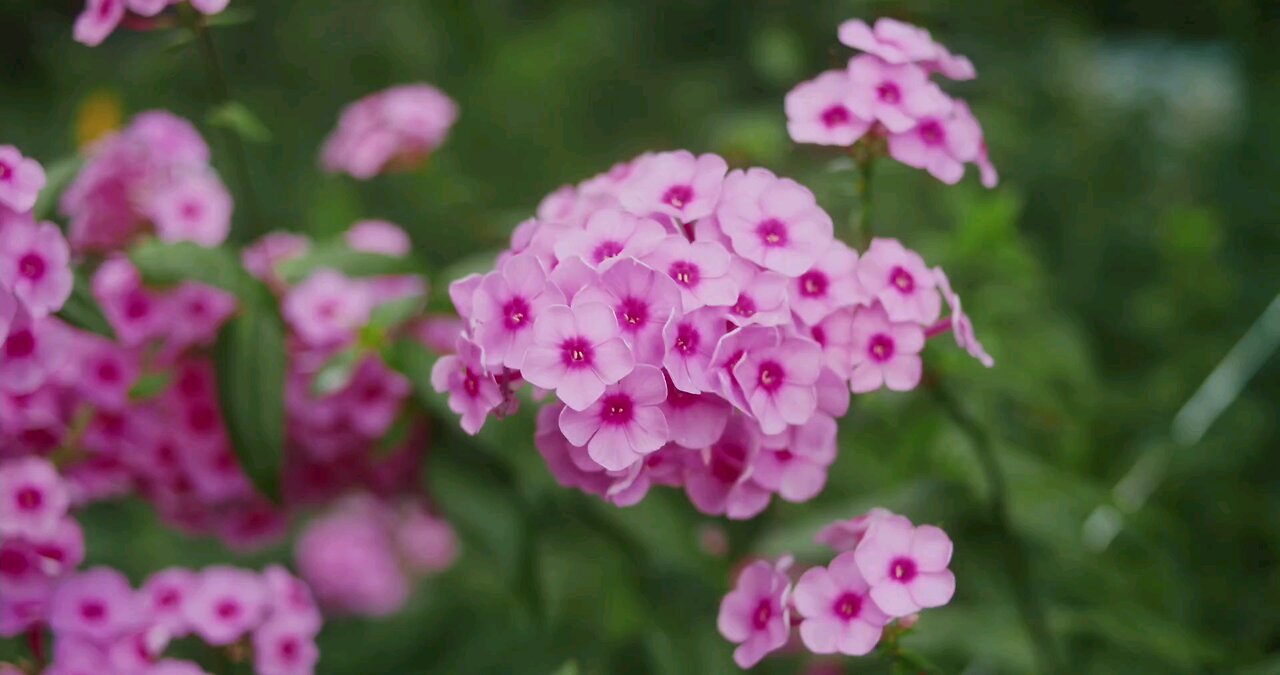Premium Only Content

"Pink Phlox Paniculata: Attracting Pollinators and Brightening Landscapes"
Phlox paniculata, commonly known as garden phlox or tall phlox, is a perennial flowering plant known for its vibrant, fragrant blooms. Pink phlox refers to varieties of this species that exhibit pink flowers. Here’s an overview:
Description:
Appearance: Phlox paniculata typically grows to a height of 2 to 4 feet (60 to 120 cm) and features sturdy stems that can support large clusters of flowers. The flowers are often star-shaped and can vary in color, with pink being one of the most popular varieties.
Leaves: The leaves are lance-shaped, dark green, and grow in opposite pairs along the stem. They can reach lengths of about 4 to 6 inches (10 to 15 cm).
Blooming Season: Pink phlox blooms from mid-summer to early fall, generally between July and September. The blossoms are known for their sweet fragrance, attracting pollinators like bees and butterflies.
Habitat and Distribution:
Native to eastern North America, Phlox paniculata typically grows in open woods, meadows, and along roadsides. It prefers well-drained, fertile soil and full sun to partial shade, thriving in USDA hardiness zones 4 to 8.
Cultivation:
Pink phlox is a popular choice for garden landscapes due to its vibrant colors and ability to attract pollinators. It is often used in borders, cottage gardens, and as a cut flower.
The plant prefers well-drained soil rich in organic matter. It is relatively low-maintenance, although regular watering is necessary during dry spells.
Deadheading spent flowers can promote longer blooming periods, and it is advisable to cut back the plants in the fall to maintain their health.
Ecological Importance:
Phlox paniculata is valuable for pollinators, providing nectar and pollen to bees, butterflies, and hummingbirds. Its blooms are an important food source during the summer months.
Uses:
In addition to its ornamental uses, pink phlox has been used in traditional medicine for various ailments, although it is primarily cultivated for its beauty in gardens.
Some cultivars of Phlox paniculata are resistant to powdery mildew, a common fungal disease that affects many garden phlox varieties.
Conclusion:
Pink Phlox paniculata is a stunning and fragrant addition to any garden, offering bright colors and attracting beneficial pollinators. Its hardiness and ease of care make it a favorite among gardeners looking to enhance their landscapes with vibrant blooms.
-
 58:19
58:19
Ben Shapiro
2 hours agoEp. 2131 - Trump and Musk Bring The CHAINSAW
14.4K1 -
 1:12:31
1:12:31
Russell Brand
3 hours agoTrump’s Trade Wars: Power Plays and Global Repercussions – SF531
49.6K32 -
 29:57
29:57
The Finance Hub
31 minutes agoBREAKING: DONALD TRUMP JR. JUST DROPPED A MAJOR BOMBSHELL!!!
1 -
 1:57:48
1:57:48
The Charlie Kirk Show
2 hours agoTrump Gets His Cabinet + Killing the USAID Grift + Why Bud Light Collapsed | Frericks | 2.4.2025
91.2K23 -
 1:21:47
1:21:47
Simply Bitcoin
2 hours ago $1.05 earnedDid America JUST Change The Bitcoin Nation State Race Forever?! | EP 1175
12.5K1 -
 37:13
37:13
Grant Stinchfield
2 hours ago $1.21 earnedBill Gates is Making the Media Rounds Today to Push the Vax and Stop RFK Jr.
8.02K13 -
 DVR
DVR
TheAlecLaceShow
3 hours agoGuest: Rep. Burgess Owens | Trump Wins with Mexico & Canada | DNC Diversity | The Alec Lace Show
6.17K4 -
 1:00:28
1:00:28
The Dan Bongino Show
4 hours agoTrump’s Most Important Fight To Date (Ep. 2415) - 02/04/2025
603K1.01K -
 59:44
59:44
The Rubin Report
3 hours agoPress Gasps When Shown What USAID Spent Money On
77.3K112 -
 1:15:21
1:15:21
Bare Knuckle Fighting Championship
4 hours agoThe Bare Knuckle Show with Brian Soscia
13.7K2